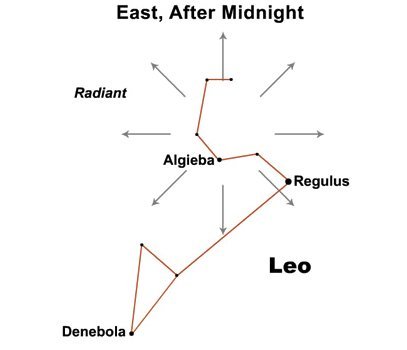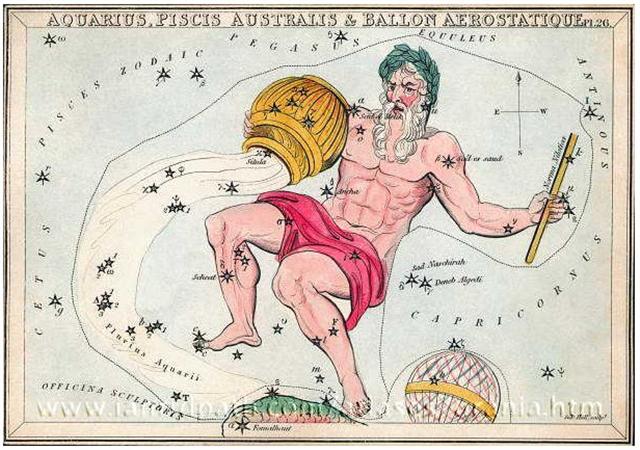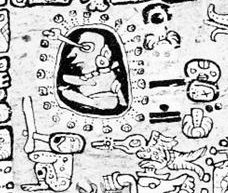368. By counting 90 glyphs ahead from Antares in Ga7-16 we will reach the DECEMBER solstice, when Castor would have culminated at 21h:
And from there only 5 days remained to the Rain star (η Pegasi):
According to the Chinese the winter solstice came soon after the beginning of April: ... In China, every year about the beginning of April, certain officials called Sz'hüen used of old to go about the country armed with wooden clappers. Their business was to summon the people and command them to put out every fire. This was the beginning of the season called Han-shih-tsieh, or 'eating of cold food'. For three days all household fires remained extinct as a preparation for the solemn renewal of the fire, which took place on the fifth or sixth day after the winter solstice [Sic!] ... However, above we can see that the winter solstice (like 0h) came earlier and earlier as observed against the background of the fixed stars:
Should we instead let the winter solstice stand still it would imply we had abandoned the stars in favour of the Sun, we had adopted a solar calendar. The distance from the winter solstice to the beginning of April could then be measured as 11 (from 355 to 366) + 91 (April 1) = 102 days. Or, by counting ahead as 355 - 91 = 264 days. When the Chinese put out all their fires this implied also all sweet water ought to have disappeared, because these contrasting fundamentals were complementary. They could not - like the ebb and flood created by the Moon - exist separately. Addition implies subtraction, multipliction implies division etc). ... He was moreover confronted with identifications which no European, that is, no average rational European, could admit. He felt himself humiliated, though not disagreeably so, at finding that his informant regarded fire and water as complementary, and not as opposites. The rays of light and heat draw the water up, and also cause it to descend again in the form of rain. That is all to the good. The movement created by this coming and going is a good thing. By means of the rays the Nummo draws out, and gives back the life-force. This movement indeed makes life. The old man realized that he was now at a critical point. If the Nazarene did not understand this business of coming and going, he would not understand anything else. He wanted to say that what made life was not so much force as the movement of forces. He reverted to the idea of a universal shuttle service. 'The rays drink up the little waters of the earth, the shallow pools, making them rise, and then descend again in rain.' Then, leaving aside the question of water, he summed up his argument: 'To draw up and then return what one had drawn - that is the life of the world' ... From this it seems quite probable that the star who drank up all the waters could have been involved: ... The Pythagoreans make Phaeton fall into Eridanus, burning part of its water, and glowing still at the time when the Argonauts passed by. Ovid stated that since the fall the Nile hides its sources. Rigveda 9.73.3 says that the Great Varuna has hidden the ocean. The Mahabharata tells in its own style why the 'heavenly Ganga' had to be brought down. At the end of the Golden Age (Krita Yuga) a class of Asura who had fought against the 'gods' hid themselves in the ocean where the gods could not reach them, and planned to overthrow the government. So the gods implored Agastya (Canopus, alpha Carinae = Eridu) for help. The great Rishi did as he was bidden, drank up the water of the ocean, and thus laid bare the enemies, who were then slain by the gods. But now, there was no ocean anymore! Implored by the gods to fill the sea again, the Holy One replied: 'That water in sooth hath been digested by me. Some other expedient, therefore, must be thought of by you, if ye desire to make endeavour to fill the ocean ...
At the time of Gregory XIII the distance from 0h to Canopus had been precisely a quarter of 364 days. I.e. Canopus rose 91 days after the new Gregorian spring equinox (°March 21). Therefore Canopus in a way had been fixed to a position in the day preceding the summer solstice (172 = 80 + 92), implying 3 days of cold food before the day of St John the Dipper. To be immersed in sweet water seems to have meant a new fire was born. ... The Mahabharata insists on six as the number of the Pleiades as well as of the mothers of Skanda and gives a very broad and wild description of the birth and the installation of Kartikeya 'by the assembled gods ... as their generalissimo', which is shattering, somehow, driving home how little one understands as yet. The least which can be said, assuredly: Mars was 'installed' during a more or less close conjunction of all planets; in Mbh. 9.45 (p. 133) it is stressed that the powerful gods assembled 'all poured water upon Skanda, even as the gods had poured water on the head of Varuna, the lord of waters, for investing him with dominion'. And this 'investiture' took place at the beginning of the Krita Yuga, the Golden Age ... The Pope had therefore in a way fixed all the other stars as if Canopus had been their leader. 288 (°October 15,*208) - (°June 20, *91) = 117 (= 9 * 13). Perceiving time in the night from observing the place among the stars of the Face of the Full Moon - as when searching on Easter Island for the corresponding season - the place of Canopus would be found in late December. Possibly the Chinese also looked towards the Moon for guidance.
But the Pope had primarily chosen Sirius (the brightest of all the nighttime stars and the force returning the waters) rather than Canopus (taking all the waters away). And 3 days of cold food could then be said to correspond to °June 27 - 29 (178 - 180). In other words °June 26 (177) would be the last day with hot food. Day 177 = 6 * 29½ = 354 / 2.
There was a complication because in the Sun calendar 11 more days were needed in order to cover the time ffrom day 354 to day 365. Or 10 more if 364 = 4 * 91 was regarded as the last day of the year (and day 365 as day zero of the following year). From the time when Hotu arrived to Easter Island to the day when the Explorers sailed away from the island there were 10 days. Or 11 if "October 15 also was counted.
|
||||||||||||||||||||||||||||||||||||||||||||||||||||||||||||||||||||||||||||||||||||||||||||||||||||||||||||||||||||||||||||||||||||||||||||||||||||||||||||||||||||||||||||||||||||||||||||||||||||||||||||||||||||||||||||||||||||||||||||||||||||||||||||||||||||||||||||||||||||||||||||||||||||||||||||||||||||||||||||||||||||||||||||||||||||||||||






















